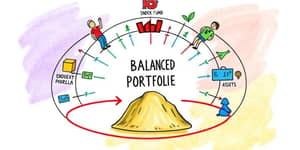
In an investment world often likened to a roller coaster, achieving stable returns can feel like chasing a mirage. Rapid rallies in technology stocks can be thrilling, but steep drops leave many investors unsettled.
Balancing excitement and security requires a strategic blend of investment styles. By diversify across market cycles and combining complementary approaches, you can build a portfolio designed to weather any storm.
At their core, growth stocks represent companies expected to expand revenue and earnings at above-average rates. They often reinvest profits into research, development, and aggressive market expansion, rather than paying dividends.
In contrast, value stocks are mature businesses trading below intrinsic worth. They typically offer higher dividend yields and stable cash flows, appealing to investors seeking reliable income.
Recognizing each style’s characteristics is the first step to capture different market leadership cycles and construct a resilient allocation.
Growth stocks typically trade at elevated P/E and P/B ratios, reflecting the market’s faith in future prospects. Value stocks, by contrast, often carry lower multiples, signaling potential bargains when fundamentals remain sound.
Over the last 20 years, growth stocks outpaced value in 14 years, including eight of the last ten. When they win, they tend to deliver substantial margins—averaging 2.5 percentage points of monthly outperformance.
Yet value stocks have claimed the lead in 46% of months over two decades, often shining in downturns. They delivered less dramatic but consistent weekly gains, underperforming growth traps to a lesser degree.
This ebb and flow highlights why investors should smooth out return volatility over time by harnessing the strengths of both styles without chasing the latest trend.
Growth stocks can soar on positive earnings surprises, but they can also suffer dramatic drawdowns if forecasts falter. These “growth traps” occur when high expectations collide with slower-than-anticipated progress.
Value stocks face their own pitfalls: the “value trap,” where cheap prices persist due to underlying challenges in a company’s business model. Yet such declines tend to be more moderate, offering a measure of downside protection.
By blending these approaches, investors mitigate extremes. The higher volatility of growth can be tempered by the stability of value, creating a smoother ride through market turbulence.
Integrating growth and value stocks offers several key advantages that blend performance potential with downside protection:
Through this mix, investors can maintain disciplined portfolio rebalancing practices to lock in gains from outperforming segments and redeploy into underappreciated ones.
Ultimately, a blended strategy enhances resilience, allowing participation in rapid growth upswings while cushioning against prolonged downturns.
Allocating between growth and value stocks requires thoughtful planning and ongoing adjustments. A disciplined framework ensures you stay aligned with your financial goals and risk tolerance.
Over time, this systematic approach can help investors combine complementary investment styles effectively and maintain a balanced risk-reward profile.
Interest rates, inflation, and global growth prospects will continue to drive rotations between value and growth. In a rising-rate environment, dividend-paying value stocks often shine, offering income-oriented holdings with stable cash flows.
Conversely, periods of falling rates and robust economic expansion can fuel growth sectors like technology and consumer discretionary, rewarding companies with strong earnings momentum and future potential.
Investors who stay vigilant and adhere to a balanced posture can navigate shifts smoothly, seizing opportunities in both defensive and aggressive segments of the market.
Blending growth and value stocks offers a powerful framework for achieving more stable investment returns over the long term. Through diversification, disciplined rebalancing, and an awareness of macro trends, you can build a portfolio designed to thrive in both bull and bear markets.
Embrace the synergy of growth’s upside potential and value’s defensive ballast to embark on a more confident and resilient investment journey.
References













